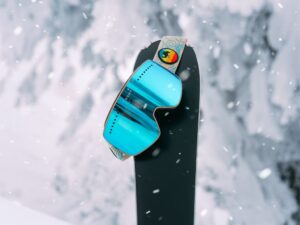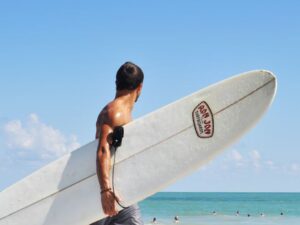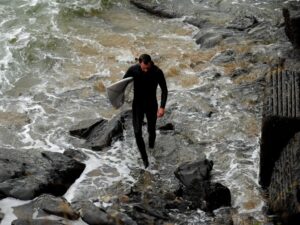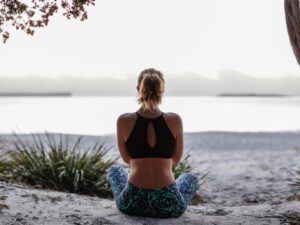Hey snowboarding enthusiasts and fitness fanatics! Ever wondered if snowboarding does more than just give you an adrenaline rush? Can it actually build muscle?
When you strap on that snowboard, you’re in for a full-body workout beyond the sheer fun of it all. Snowboarding demands strength, balance, and endurance, engaging various muscle groups. So, let’s dive in and dissect each group.
Imagine carving those turns down the mountain, feeling the burn in your legs as you powerfully shift your weight. Your lower body muscles are hard at work, with your quadriceps propelling you forward, your hamstrings stabilizing your movements, and your calves providing strength and support.
But it doesn’t just stop there. Snowboarding also activates your core, keeping your abdominals, obliques, and lower back muscles concentred and balanced. Even your upper body muscles play a role in maintaining control and posture.
So, to sum up…
Snowboarding primarily activates the lower body muscles, including the quadriceps, hamstrings, and calves. Additionally, it engages core muscles such as the abdominals, obliques, and lower back. Upper body muscles like the deltoids, trapezius, rhomboids, biceps, and triceps also play an important role.
So, whether you’re a seasoned snowboarder or just starting out, get ready to discover the incredible muscle-building potential of this thrilling winter sport.
What muscles does snowboarding use?
Snowboarding is a dynamic sport that engages various muscle groups throughout your body. Each muscle is vital in maintaining balance, stability, and control while riding from the lower body to the core and upper body. Let’s get to it.
1. Lower Body Muscles
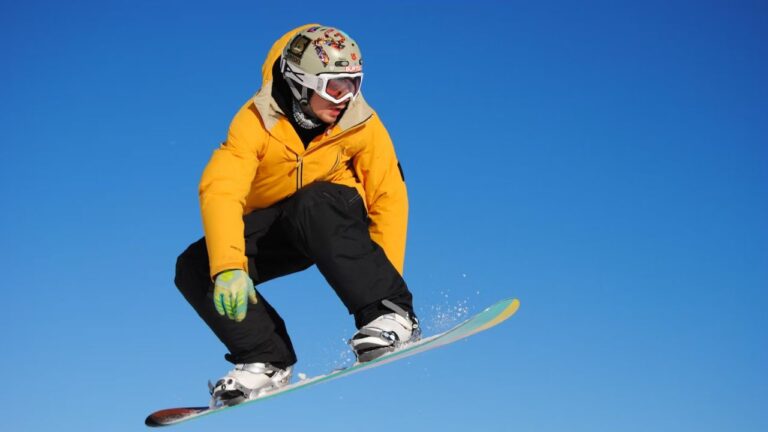
a. Quadriceps:
The quadriceps, located at the front of your thighs, are among the primary muscles used in snowboarding. They’re responsible for extending your knees and powering turns and jumps.
As you shift your weight from one edge of the board to the other, the quadriceps engage to maintain stability and generate the force needed to maneuver effectively.
b. Hamstrings:
Located at the back of your thighs, the hamstrings act as stabilizers and play a significant role in maintaining balance and control while snowboarding.
They work in opposition to the quadriceps, assisting in flexing the knees and absorbing shock during jumps and landings.
c. Calves:
Your calf muscles, composed of the gastrocnemius and soleus muscles, provide support and assist with balance. As you shift your weight from heel to toe or quickly adjust your stance, the calves come into play, aiding ankle flexion and extension.
2. Core Muscles
a. Abdominals:
The abdominal muscles, including the rectus abdominis and the deeper transverse abdominis, are vital for maintaining stability and balance on the snowboard.
These muscles stabilize your spine and pelvis, preventing excessive leaning and ensuring a solid foundation.
b. Obliques:
The oblique muscles on the sides of your torso contribute to rotational movements while snowboarding.
They assist in generating the twisting motion needed for turns and tricks, allowing you to initiate and control your movements effectively. The obliques also play a role in maintaining proper posture and balance, especially during dynamic maneuvers.
c. Lower Back:
The lower back muscles, including the erector spine and multifidus, provide support and stability to your spine while snowboarding. They help maintain an upright posture, distribute the forces generated during turns, and absorb shock.
3. Upper Body Muscles
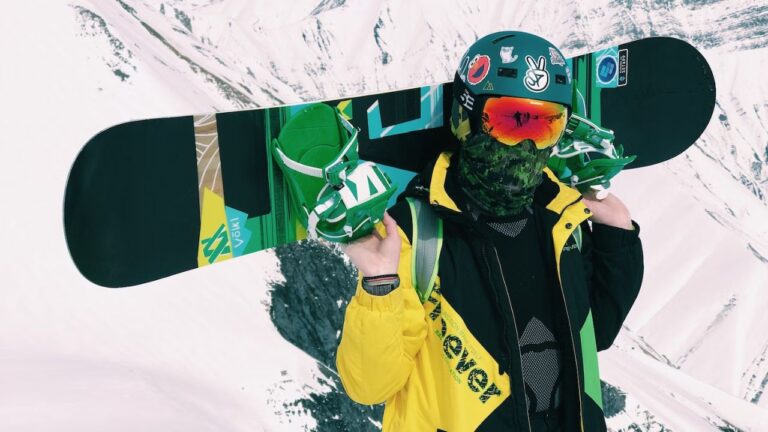
a. Deltoids:
The deltoid is responsible for upper body stability and control during snowboarding. They assist in raising and lowering your arms, allowing you to maintain balance and control your body position while riding.
b. Trapezius:
The trapezius muscle, spanning from the base of your skull to your mid-back, plays a significant role in snowboarding. It helps maintain proper posture, keeps your head aligned, and aids in stabilizing the shoulder girdle.
The trapezius also assists in rotational movements of the upper body, facilitating smooth turns and maneuvers.
c. Rhomboids:
The rhomboid muscles, located between your shoulder blades, retract and stabilize your shoulder blades.
They’re crucial in maintaining upper body stability and control, especially when carving turns or executing tricks involving upper body movements.
d. Biceps and Triceps:
The biceps in the front of your upper arm assist in flexing the elbow and provide support during jumps and maneuvers.
In comparison, the triceps at the back of your upper arm help extend the elbow and maintain upper body stability. These muscles play a supportive role in snowboarding and are engaged during various movements on the slopes.
Does snowboarding help you build muscle?
Snowboarding is more than just a thrilling winter sport—it’s also an effective way to build and strengthen your muscles. Let’s tell you how.
1. Activation and Strengthening of Muscle Groups
The combination of dynamic turns jumps, and tricks challenges your muscles and forces them to adapt and grow stronger over time. The repetitive nature of snowboarding movements, such as squatting, bending, and twisting, helps increase muscle activation and promote muscle development.
2. Muscle Growth and Toning
Regular snowboarding can lead to muscle growth and toning, especially with a balanced diet and appropriate recovery. The resistance provided by the snow, the terrain, and the movements themselves stimulates the muscles, leading to hypertrophy and increased muscle size.
Snowboarding primarily develops lean muscle mass, providing a sculpted and toned appearance rather than bulky muscles. It also engages both slow-twitch and fast-twitch muscle fibers, contributing to overall muscle development.
Slow-twitch fibers are responsible for endurance and are highly activated during prolonged rides, while fast-twitch fibers are engaged during explosive movements, jumps, and tricks.
You can even target different muscle fibers and promote balanced muscle development by incorporating various snowboarding techniques and intensities.
3. Cardiovascular Benefits and Overall Fitness
In addition to muscle development, snowboarding offers significant cardiovascular benefits. The constant movements jumps, and maneuvers elevate your heart rate, leading to increased cardiovascular output and improved aerobic capacity.
Is snowboarding good for weight loss?
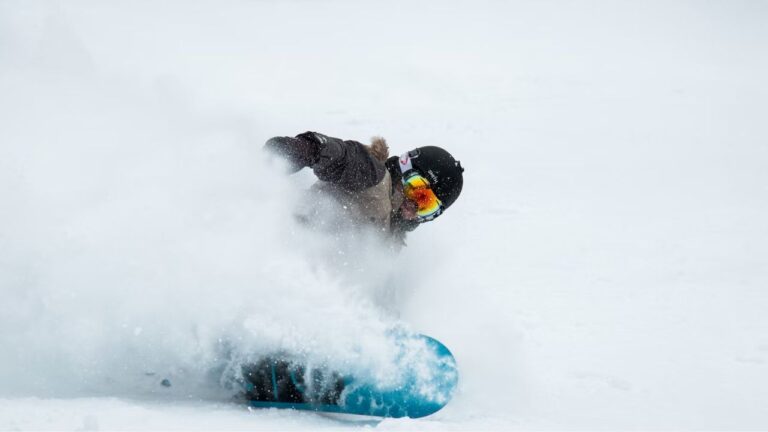
Snowboarding can be an effective activity for weight loss when combined with a balanced diet and a consistent training regimen. The high-energy demands and the engagement of multiple muscle groups make it an efficient calorie-burning sport.
Reason #1: Calorie Expenditure
The constant movements turns, jumps, and maneuvers require energy, leading to an increased metabolic rate and calorie expenditure. That said, the exact number may depend on individual factors such as body weight, the activity’s intensity, the session’s duration, and fitness levels.
Reason #2: Full-Body Workout
Snowboarding engages various muscle groups throughout your body, resulting in a comprehensive full-body workout. The continuous activation of muscles, especially in the lower body and core, increases energy expenditure and contributes to muscle toning and development.
Reason #3: Interval Training Effect
Snowboarding involves alternating periods of intense activity, such as carving turns or performing tricks, with periods of lower intensity, such as cruising down the slopes.
This interval training effect can boost calorie burn by increasing the metabolic rate and stimulating fat oxidation.
Reason #4: Enjoyable and Sustainable
One of the keys to successful weight loss is finding an activity you enjoy and can sustain over time.
When you’re having fun and engaged in the activity, you’re more likely to stay consistent and incorporate snowboarding into your regular routine, contributing to long-term weight loss.
Exercises to Complement Your Snowboarding Routine
While snowboarding provides a comprehensive workout, incorporating supplementary exercises and training activities can further enhance your performance and muscle development.
These exercises target specific muscle groups, improve strength, flexibility, and balance, and help prevent injuries.
1. Leg and Core Exercises
Squats: Squats are a compound exercise that targets the quadriceps, hamstrings, and glutes—key muscle groups used in snowboarding. They improve lower body strength, stability, and power.
Lunges: Lunges target the quadriceps, hamstrings, and glutes and help improve balance and stability, particularly during one-legged movements in snowboarding.
2. Balance and Stability Exercises
Bosu Ball Training: Bosu balls are great for improving balance and stability. Performing single-leg stands, squats, and lunges on a Bosu ball challenges your core and lower body stability.
Yoga and Pilates: These practices focus on improving balance, flexibility, and core strength—essential components for snowboarding. Poses like the tree pose, warrior pose, and plank variations are particularly beneficial.
3. Upper Body and Core Exercises
Planks: Planks are a fantastic core exercise that targets the abdominals, obliques, and lower back. A strong core is crucial for stability and control while snowboarding.
Resistance Band Training: Incorporating exercises with resistance bands, such as rows, shoulder presses, and lateral raises, helps strengthen the upper body muscles used in snowboarding.
Expert QnA
Q. Can beginners benefit from snowboarding?
Beginners can experience muscle development through snowboarding too. Even though initial sessions may focus more on learning techniques and balance, the physical demands of snowboarding still engage and challenge various muscle groups, leading to improvements in strength and endurance over time.
Q. How often and for how long should I snowboard to see muscle-building results?
Consistency is key, and regularly engaging in snowboarding activities, combined with proper technique and intensity, will help you see muscle-building results. Aim for a balanced approach, gradually increasing your time on the slopes as your fitness and skill level improves.
Q. Can snowboarding replace other forms of exercise for muscle development?
Snowboarding can greatly add to your fitness routine and contribute to muscle development. However, to achieve well-rounded strength and overall fitness, it’s advisable to incorporate various exercises and workouts that target different muscle groups and aspects of fitness, including cardiovascular exercises.


